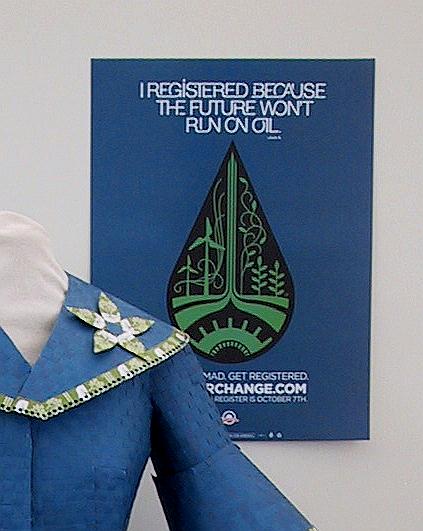Recycle Runway Blog
Creating the ECO FASHION WEEK Collection
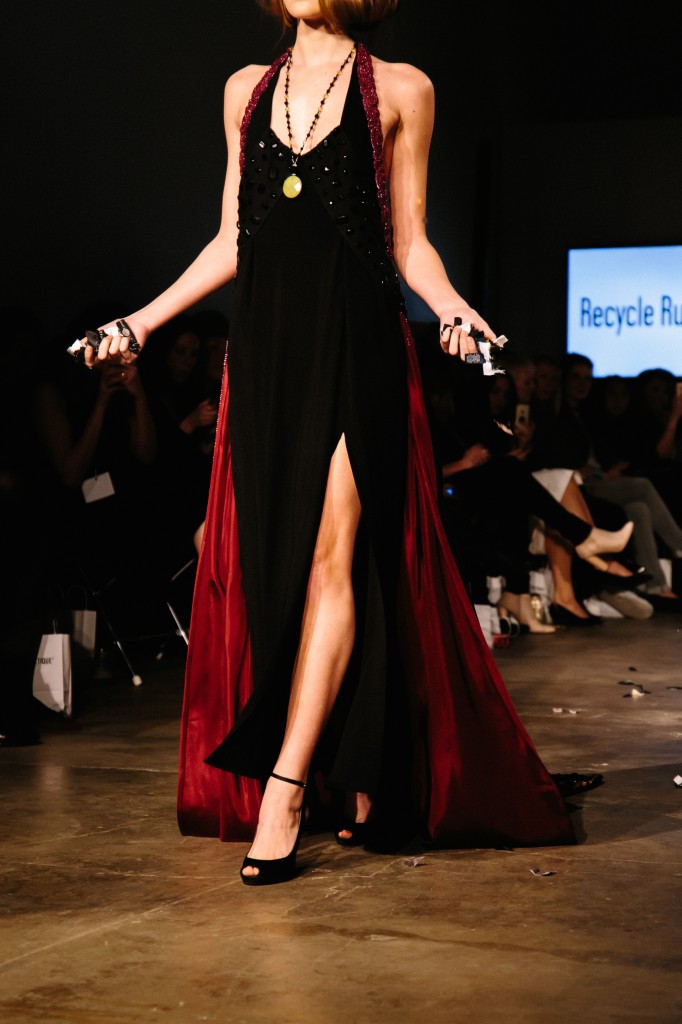 In my first blog post, I explained that through preparing new work for ECO FASHION WEEK, I took a deep dive into the environmental and social impacts of our clothing. In my second post I explored the world of fast fashion. In my third post I used the journey of a simple T-Shirt to see how the clothing industry is the second most polluting industry in the world after oil.
In my first blog post, I explained that through preparing new work for ECO FASHION WEEK, I took a deep dive into the environmental and social impacts of our clothing. In my second post I explored the world of fast fashion. In my third post I used the journey of a simple T-Shirt to see how the clothing industry is the second most polluting industry in the world after oil.
This 4th post of my series will actually be the story of my experience participating in ECO FASHION WEEK last November. ECO FASHION WEEK, or #EFW, explores the environmental and social issues related to the fashion industry, and I was invited to both participate as a panelist in the Collective Conversation and to share new work on the runway.
I was one of ten designers and stylists that participated in a part of #EFW called: Runway ReImagined: Project 8.1. Individually, each of the ten designers used 8.1 pounds of upcycled clothing to create a small collection of garments. But collectively, we created couture weighing a total of 81 lbs, the astounding average weight of the clothing that each North American discards annually!
My first step in preparing for this project was to do a massive amount of research (which led to this five part blog series). You see, even though I am often mistaken for a fashion designer I have no background in the fashion industry. Indeed, the garments I create have another purpose altogether which is to open a dialogue, to educate, and to empower action about resource use and environmental negligence. I have chosen to not create fashion due to what I know about resource use and our throw away culture. So, I considered my invitation to be a participant in #EFW as an opportunity to deepen my understanding of fashion’s social and environmental impacts.
I knew that I wanted to create a body of work that would begin to address what I was learning visually, giving me a spring board to initiate conversations with people about the true cost of the clothing we wear. After a lot of reading I realized that much of story of these social and environmental impacts is told by the labels and tags found in our clothing. We can learn WHAT our clothes are made from and WHERE they were sewn, which can tell us WHO created them and HOW that person lives and works. Now that you’ve read the last three blog posts you can see a road-map to deciphering these stories.
I conceptualized and created a collection of three pieces for the show. Instead of being a collection with a coherent feel or look exclusively, each garment was designed to unfold the story of the true cost as a performance piece. My partner, Nicole, helped me to put together some of the nuances of staging and music. In a brilliant flash of inspiration, she chose, “Mercy, Mercy Me (the Ecology),” by Marvin Gay — released in 1971, sadly, the lyrics could not be more relevant today.
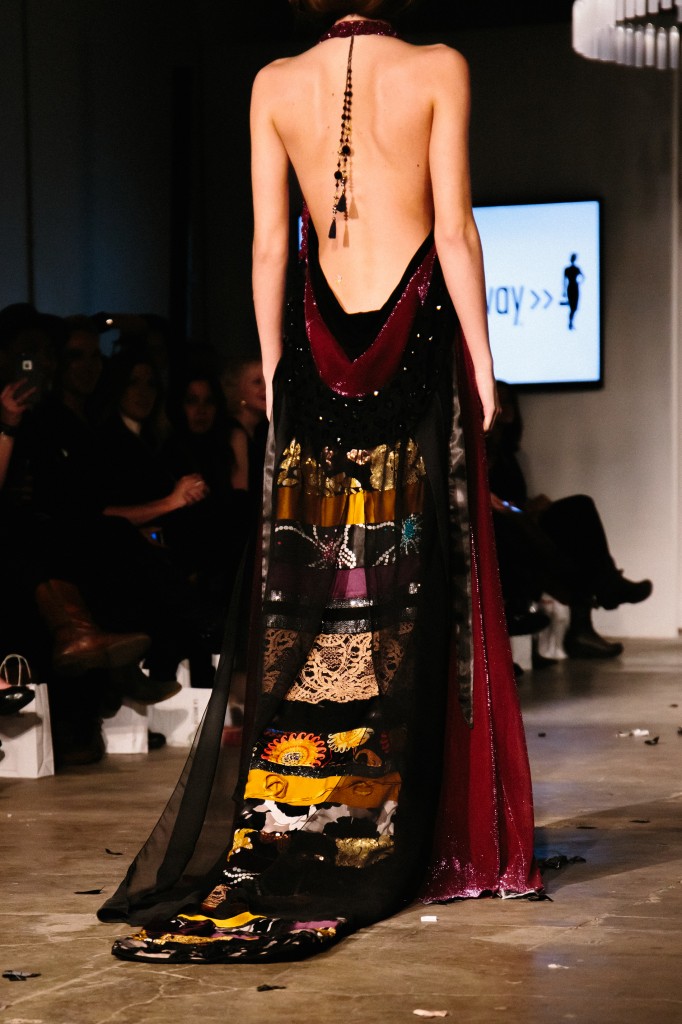 The first of the three “looks” (as each individual garment is called in a fashion show) is an opulent and elegant dress that flows gracefully and is trailed by a long, bejeweled train. The model wearing it walks down the runway while, almost unconsciously, dropping labels from her hands as she proceeds.
The first of the three “looks” (as each individual garment is called in a fashion show) is an opulent and elegant dress that flows gracefully and is trailed by a long, bejeweled train. The model wearing it walks down the runway while, almost unconsciously, dropping labels from her hands as she proceeds.
Here, I’m going to indulge myself a moment as I describe the process of making this dress – it was just SO MUCH FUN!! Beginning with a big black turtle-neck dress (the base garment) I began creating a 3D “sketch” right on the dress-form, something within the fashion industry known as draping. I madly snipped and pinned away at garments that had little or no appeal to me carving them into a spectacular new design with great appeal! I kept remembering in that moment a similar incident in 1st grade when I took my cousin into the bathroom with a pair of scissors and instructed her to shorten my dress. Turned out she was unwilling, so I did it myself!
Next I cut up a maroon double layered dress using part of it as an embellishment around the hips to accentuate the small waist and incorporating a large portion of it as the back of the skirt. Additionally, I carefully snipped off a braided portion to wrap around the model’s neck which carried the weight of the train. Then I cut off a hem bejeweled with big black plastic rhinestones from a different black dress and draped it on either side of the plunging neck line down and around to meet at the back. The rhinestones incorporated both texture and shine to an otherwise muted bodice and replicated the shiny accents I would use in the train. I grabbed about 12 shirts, skirts and dresses with patterns, colors and textures that I liked, folded them into little strips, and laid then next to each other to form the Chapel train (a train trailing 3 to 4 feet). While molding this creation, I was looking at drawings of one of my very favorite designers Erte, from the 1930’s. His gravity defying art deco fashion designs have always enchanted me. And I love how he uses opulent fabrics to accent clean and dramatic lines. Within an hour this dress was designed and ready to be sewn together. It was such a fun and spontaneous experience!
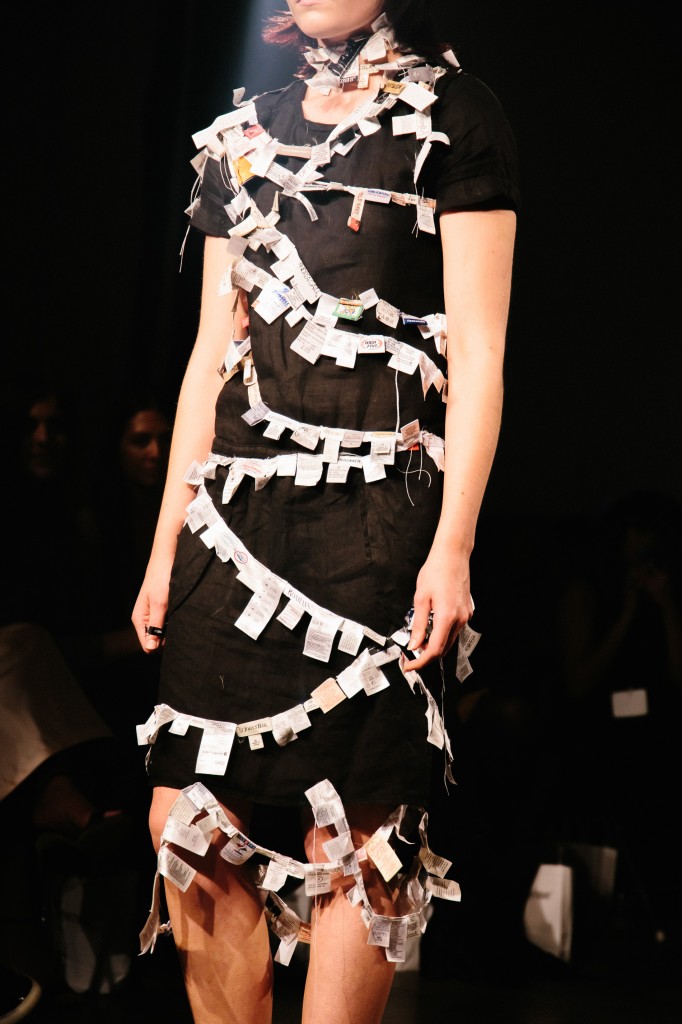 The second “look”, is a simple black shift worn inside out. The woman wearing the shift is of Asian descent and has no makeup, plain shoes, and a simple haircut. (Though not a new idea, I liked the symbolism of turning fashion inside out and exposing the story under the garment.) The dress is bound by hundreds of labels sewn together, appearing like mini prayer flags or laundry hanging on lines between old tenement buildings. As the model walks down the runway, she picks up the labels dropped by the first model. In the 1990s during my last year of college I had a solo senior art show of photographs called “In the wake of our Steps” which explored the degradation of the California landscape due to over development. That line kept running through my mind as I imaged the model wearing the label strewn dress picking up the labels littered by the first model.
The second “look”, is a simple black shift worn inside out. The woman wearing the shift is of Asian descent and has no makeup, plain shoes, and a simple haircut. (Though not a new idea, I liked the symbolism of turning fashion inside out and exposing the story under the garment.) The dress is bound by hundreds of labels sewn together, appearing like mini prayer flags or laundry hanging on lines between old tenement buildings. As the model walks down the runway, she picks up the labels dropped by the first model. In the 1990s during my last year of college I had a solo senior art show of photographs called “In the wake of our Steps” which explored the degradation of the California landscape due to over development. That line kept running through my mind as I imaged the model wearing the label strewn dress picking up the labels littered by the first model.
The third “look” is a simple man’s T-shirt which has letters from other T-shirts sewn to it reading: “Labels, what stories do they tell?” The labels we use for anything always tells us more about what lies underneath than the mere name. To tie this tale of international exploitation back to our current national social justice issues I requested a model of African American descent for this piece. To me all three of these pieces reference each other. You guessed it! The first piece of the performance was conspicuous consumption, the second was the hidden story of exploitation, and the final piece tells you where to find the story. The video below was created by #EFW where you can see samples from all the fabulous designers that participated. My collection and the performance piece begins at 1 minute, 38 seconds and has been powerfully abbreviated into 16 seconds of footage.
Creating this collection was a new and exciting experience for me in several ways. I had never participated in a fashion week before, nor had I ever created a performance piece, and I really took on the challenge with music, performers, and costumes. Also, it was the first time I used exclusively fabric– no rusty nails, broken glass or car parts! What a relief, no dramatically unmalleable objects! Whew! Lastly, this was the first time I have directly explored the price of fashion in my work. I really enjoyed this project and as well as the flow of inspiration that inevitably comes when a good challenge is put before me.
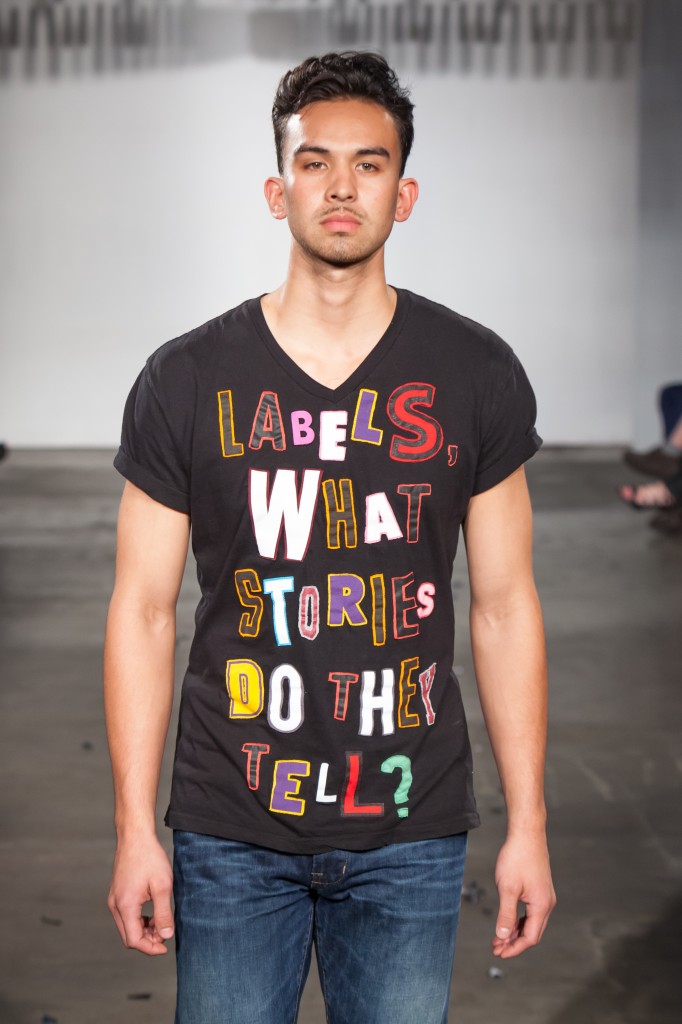 I also spoke in the Collective Conversation, a full day symposium on the last day of #EFW that explores solutions and innovations to develop a more sustainable and responsible fashion industry. Ideas such as zero-waste production, environmentally-conscious textile treatment and development, as well as shifts in overall consumption were discussed. As a panelist, one of my contributions to the conversation was to remind the audience that we were sitting on land that originally belonged to the Duwamish and Suquamish people (descendants of Chief Seattle) who have lived in the Americas for around 10,000 years. In the comparatively short 200 years that colonists have been here, we have (thanks to the consumptive patterns discussed in this series) made this planet arguably unlivable for many plants and animals, including humans. Today more than ever we have much to learn from Native Americans, and in the fashion industry there are native designers leading the way. A few to check out are: Ginew (brilliant, young, insightful designers and are both medical doctors), Sho Sho Esquiro, Bethany Yellowtail, Jamie Okuma, Alano Edderza, Dorthy Grant, and Louie Gong of 8th Generation (he has a shop in Pike Place Market in Seattle).
I also spoke in the Collective Conversation, a full day symposium on the last day of #EFW that explores solutions and innovations to develop a more sustainable and responsible fashion industry. Ideas such as zero-waste production, environmentally-conscious textile treatment and development, as well as shifts in overall consumption were discussed. As a panelist, one of my contributions to the conversation was to remind the audience that we were sitting on land that originally belonged to the Duwamish and Suquamish people (descendants of Chief Seattle) who have lived in the Americas for around 10,000 years. In the comparatively short 200 years that colonists have been here, we have (thanks to the consumptive patterns discussed in this series) made this planet arguably unlivable for many plants and animals, including humans. Today more than ever we have much to learn from Native Americans, and in the fashion industry there are native designers leading the way. A few to check out are: Ginew (brilliant, young, insightful designers and are both medical doctors), Sho Sho Esquiro, Bethany Yellowtail, Jamie Okuma, Alano Edderza, Dorthy Grant, and Louie Gong of 8th Generation (he has a shop in Pike Place Market in Seattle).
Thank you to all the organizers and sponsors of ECO FASHION WEEK for inviting me to participate; you were all a delightful group of people to work with!
In my last post of this five part series I will explore way that we as consumers can reduce the environmental and social impacts of the clothing we wear.
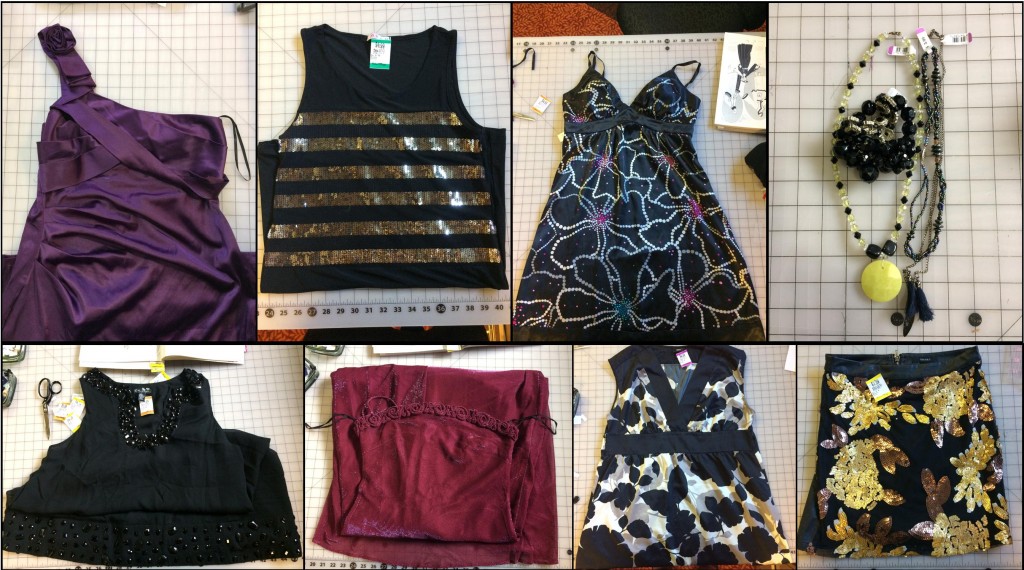
Garments and jewelry before they were incorporated into Look 1.
This series was co-researched and co-written with Nicole Morris.
Photo Credits: All photos by Nancy Judd, except runway photos by Alfonso Arnold.








































